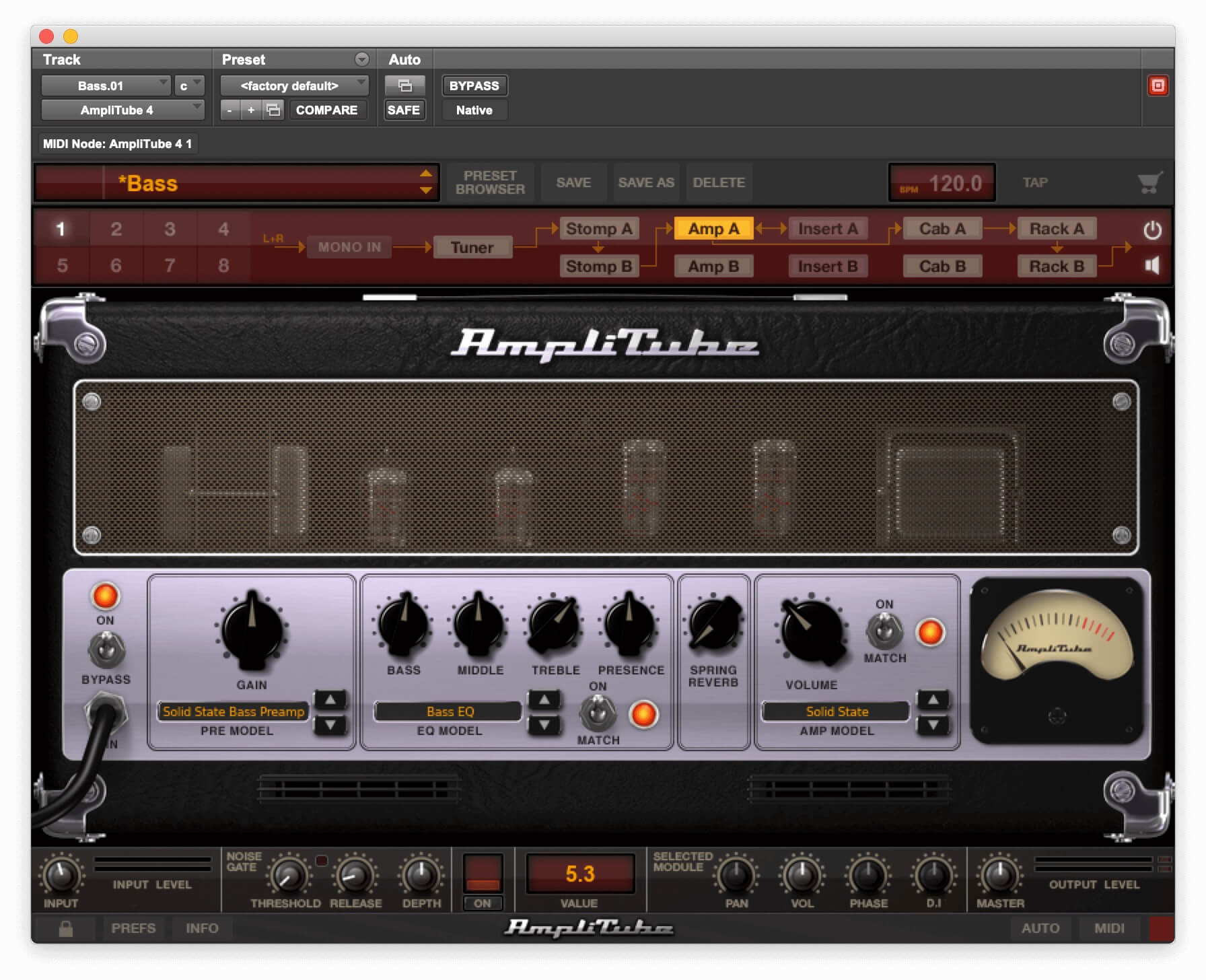Bass guitar gets recorded through a DI quite often because you can get excellent sounds without having to deal with the issues and hassle inherent in amp miking. In Episode 7 of “Greg Wells Start to Finish,” we find Greg sitting in the control room with a Rickenbacker bass in his hands, getting ready to put down the baseline for Bryce Drew’s song, “Lucky Number.”
AMP-FREE ZONE
He explains that he used to record his bass parts through an Ampeg SVT bass rig, but has now switched to using Sans Amp RBI, which is a rackmount bass processor/DI from Tech-21 that emulates the sound of a tube amp. Like the company’s other processors, it’s all analog.

Here you see the Tech-21 Sans Amp RBI, just like the one used by Wells in the video.
He points out that the single-rackmount RBI is a lot lighter than his previous bass setup, an Ampeg SVT amp with a 4x10 cabinet. What’s more, Greg says he’s gotten “some of the best bass sounds” he’s ever recorded through the RBI.
One of the features he likes on the unit is the Blend knob, which is a wet/dry control. He uses it to dial in a little bit of straight DI sound along with the processed audio. The RBI also has a Drive control, which provides an overdriven tube-like sound if you want. The RBI offers several output options, including separate wet and dry outputs, both XLR and 1/4”, an effects loop and a second input that can be switched to line-level if you’re using the RBI in a chain with other processors before it.

This drawing from Tech-21 shows the output options on the back of the RBI.
The excerpt continues with Greg recording his bass part for the song, through the RBI.
YOU’VE GOT OPTIONS
The RBI is an excellent unit, but there are also plenty of other bass amp simulator pedals available (including other Sans Amp models), for example, the Electro-Harmonix Battalion Bass, a line of units made by Darkglass, the Ashdown OriginAL Valve Pre-DI and many more. You can find them in different sizes and price ranges.
One advantage to using a bass preamp processor on input is that as the bass player, you have control over your tone. If you record straight into a DI, and you’re not involved with the mix of the song, the producer could change your tone with a bass amp plug-in or other processor in a way that you might not like.

The Ashdown Engineering OriginAL Valve Pre-DI pedal, has tube stage, lots of EQ, XLR and 1/4” outputs and more.
Recording through an external unit allows you to send your bass through an analog processor like the RBI. Another way to go would be to use your bass preamp as a hardware insert effect assuming your DAW supports that (most do). You might do that if you prefer to wait and tweak the tone during the mix.
There’s nothing wrong with recording an unprocessed DI track and then using bass amp plug-ins to get your tone. You can find some great ones on the market that can give you sounds that are close in quality and realism to what you get from an outboard bass amp modeler/preamp unit, like the RBI. Plug-ins also give you the advantage of trying multiple different settings, cabinet simulations and virtual microphones and customizing the sound to the mix.
Is it better to use a processor on input or a plug-in during the mix to get a great bass sound? Given the same bass player and bass, it’s a subjective call and depends on how you like to work. Greg prefers recording through the RBI. It’s undoubtedly simpler in that, like going through an amp, you’re committing to a sound on input.
CHECK IT OUT
But if you do decide to go the plug-in route, you can get a pretty wide range of tones, even from the same bass. Here are some examples, using different modeling plug-ins. All have a Universal Audio Urei 1176 Rev A compressor at the end of the signal chain. All were recorded with the same Fender P-Bass going direct through the hi-impedance input of a Cranborne Audio Camden mic preamp.
The first group of examples features a fingered bass part.
Ex 1a. This example is just the DI with the 1176 plug-in.
Ex 1b. Here it has the UAD SVT-VR, with 1x15 cabinet model
Ex 1c. This time the amp and cabinet models are provided by IK Multimedia AmpliTube 4. The amp is a model of a solid-state bass preamp and the cabinet is a 4x10.

The setting used for Example 1c on the IK Multimedia AmpliTube 4 bass preamp model.
A pick was used on the P-Bass to record the next group of examples.
Ex 2a: The DI sound only, with the 1176 plug-in.
Ex 2b: A UAD SVTPro provides the modeling and features a 4x10 cabinet model.
Ex. 2c: In this one you’ll hear the bass through a Line 6 Helix Native plug-in, set for distortion. Line 6 based the preamp model on a Pearce BC-1, boutique preamp, and the cabinet model is an 8x10.

This setting from the UAD SVT3 Pro, used in Example 2B